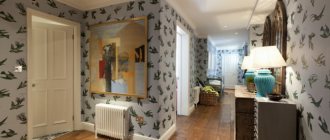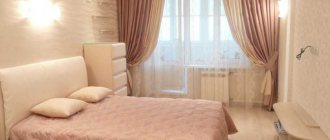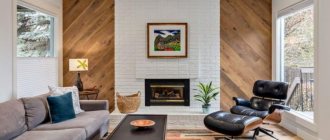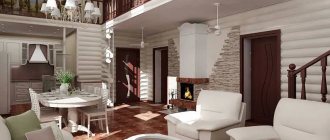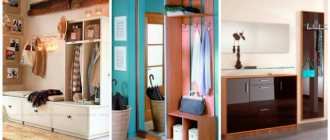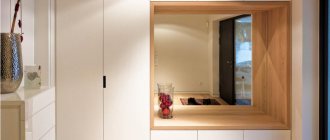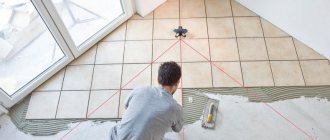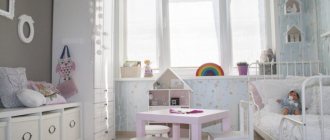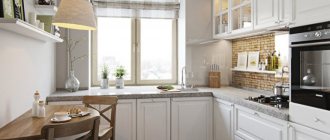A corridor or hallway is the room where apartment residents first enter when they come home from the street, so dirt and damage are sure to appear on their walls over time. If there are small children or animals in the apartment or house, then the finishing of the lower part of the wall will definitely be in a special risk area. Therefore, when starting a renovation, you need to carefully consider how to decorate the walls in the corridor so that the material is resistant to most mechanical influences.
How to decorate the walls in the corridor
In addition, it is necessary to take into account the fact that the hallway is usually the “face” of the apartment, setting the tone for the interior design of all rooms, which means that one cannot help but think not only about the strength qualities of the material, but also about its aesthetic side.
A large assortment of modern materials, which can be found in construction stores today, makes it possible to choose a finish to suit any request in terms of style and financial capabilities. However, before settling on one of the many design options, you need to consider the positive and negative aspects of the chosen approach.
Features of wall decoration in the hallway
The hallway is a kind of face of the house: it creates the first impression of it among guests. Therefore, it is important that the decor of the place is attractive. In pursuit of beauty, however, one should not forget about the purpose of the room, which imposes certain restrictions on the use of materials. To avoid having to constantly make repairs, the selected decor must have the following properties:
- Durability. Including resistance to abrasion and mechanical damage.
- Durability. It is optimal if the manufacturer guarantees a coating service life of at least 5-7 years.
- Easy to care for. Considering that the walls in the corridors are often dirty, the material should at least be resistant to wet cleaning. Ideally, it should be cleanable with a brush and the use of some detergents.
- Maintainability. It is important that the surface can be repaired. In this case, if a defect appears, it can be repaired, which is much cheaper and easier than replacing the entire surface.
- Safety. The material must be safe for the health of those nearby. In addition, fire safety must be taken into account. Do not use flammable or toxic coatings in the room where the entrance door is located. In the event of a fire, this could cost lives.
The color and texture of coatings can vary greatly. They are selected depending on the characteristics of the corridor in question. By combining materials, shades and textures, you can achieve the best results. Light shades will optically expand the space, while dark shades will narrow it. Clever use of patterns, lighting and the installation of mirrors can enhance the effect.
Recommendations
Before starting renovations in the hallway, you need to sketch out at least a rough sketch that will reflect the owners’ vision regarding filling the space with furniture, interior details, and designer decorations. It is necessary to take into account the presence of small children and animals in the apartment. Only after clarifying all the restrictions and operating conditions of the room can you begin to select specific materials and select a color scheme.
By design depending on the size of the hallway
Taking into account the dimensions of the space to be decorated, designers recommend the following solutions on how to decorate the hallway in an apartment:
- For small-sized “Khrushchev” buildings and rooms with numerous corners and protrusions, it is recommended to paint the walls in light colors.
- It is advisable to cover long, narrow corridors with vinyl wallpaper with a small pattern, placing MDF panels along the bottom of the wall to match the color of the furniture.
- Low ceilings can be compensated for by wallpaper with vertical stripes.
- Wide rooms are suitable for dark wood finishes.
By choosing the main color scheme of the interior
Before decorating a corridor in a private house or apartment, you need to decide on the color scheme. When choosing a material, consider the following tips:
- light and warm colors will allow you to visually expand the boundaries of space;
- dark colors, on the contrary, visually reduce a spacious room;
- It is recommended to match the furniture to the color of the floor covering;
- There is no need to get carried away with bright colors in the hallway design. Saturated colors can only be used as special accents.
According to the choice of material for an apartment and a private house
When selecting materials for a city apartment and a country house, you should consider some features:
- Any materials can be used for interior decoration of city apartments. The only limitation may be the total weight of the finishing elements, which should not lead to excessive load on the floor slabs;
- It is best to decorate a corridor in a private house with natural wood or tiles. The use of decorative plaster or wallpaper, especially if the house is not permanently occupied, is not recommended.
Materials for decoration
The walls in the corridor or hallway can be finished with stone, decorative plaster, wallpaper, wall panels, made in the form of brickwork, or a combination of these materials.
Decorative plaster
Thanks to the textured, imitation and color properties of decorative plaster, amazing effects can be achieved. Textured surface with various patterns, ideal for any decoration style.
Fresco
A fresco is a unique, elegant piece. Compatible with any finish. Ready-made frescoes can be purchased in stores. To create a unique design, you can order the services of an artist.
Plastic panels
Plastic panels are very often used for cladding the walls of corridors. This material is budget-friendly and available in a wide range of designs and colors.
The interior walls of the corridor made of plastic panels can be made in any style. Covering walls with this material is quite simple and easy; there is no need to level or heavily prepare the walls.
Plastic panels can be wet cleaned, but it is worth remembering that they quickly fade when exposed to direct sunlight and are also easily damaged.
Dye
Painting the walls in the hallway is the cheapest and easiest option. A wide range of paints means you can choose any shade of color for your hallway walls. Usually choose warm, pastel colors.
It is worth noting that in order for the paint to adhere well to the walls, they must be well prepared and as smooth as possible, otherwise all the flaws on the wall will be visible.
Wallpaper
Allows you to create a really interesting corridor design. Washable vinyl, laminated or photo wallpaper will not only create a unique interior, but will also last a long time.
The photo shows a spacious hallway, the walls of which are decorated with wallpaper with bird motifs.
Flexible stone
It consists of a polymer slab covered with marble chips that successfully imitate natural stone.
Ceramic tiles
Tiles are commonly used in bathrooms and kitchens. But with the right choice, they will look good in hallways. A wide selection of colors and patterns allows you to create interesting styling. Anti-scratch, practical, durable, heat-resistant and water-repellent.
The material can be used under the floor or as wall cladding. Imitation wood, stone and leather are ideal for country or country house style.
Stone
Natural or artificial stone in the hallway looks very impressive. As with creating a brick wall, the walls can be finished with stone. Apply it not to one wall, but to several. The decoration should be in the form of small inclusions.
Stone fragments are usually placed around the front door, as well as in front of it. This stylistic move immediately attracts attention.
Laminate
Inexpensive, but very effective laminate, which has many positive qualities. Laminate on the wall in the hallway can be used as an insert, or you can decorate one of the walls.
Mosaic
A variety of complex compositions, patterns and images make it extremely easy to bring color and originality to your hallway.
The photo shows a hallway with a wall decorated with a gold mosaic pattern.
Stickers
A great way to add personality and style to your living room. A variety of stickers in bright colors not only create a positive visual effect, but also help hide imperfections on the walls.
The photo shows a hallway and wall in a lilac shade, decorated with a sticker in the shape of a tree.
Bas-relief
Bas-relief is an aesthetic that attracts attention. You can create your own bas-relief and get an unusual and interesting design.
Gypsum panels and porcelain tiles
In this project, the author used several materials at once: drywall, MDF and large-format ceramics. Communications are hidden behind the panels, and the slabs visually divide the long corridor.
Design: Anush Arakelyan. View the entire project Project: Anush Arakelyan. View the entire project
Brick wall
A brick wall is a rather bold and bright solution in the interior. Products that imitate small bricks bring a special charm to the interior. Quite often, white trim is used in the hallway, which makes the room more expressive and unusual.
The photo shows a small corridor with a brick wall.
Modern ideas for decorating a hallway
Since the walls in the hallway are constantly exposed to various types of contamination, it is not recommended to use materials with a front layer, which requires delicate handling.
The most acceptable materials that do not require special care include:
- Decorative plaster.
- Certain types of wallpaper.
- Paint.
- Cork covering.
- Artificial stone with imitation of natural materials.
- PVC panels.
- Ceramic tiles.
- Composite 3D panels.
- Frescoes.
- Tree.
- Laminate.
- Bamboo.
Decorative plaster
A modern and widely used material for the hallway, which, thanks to a wide variety of textures and shades, can give this room a special uniqueness. Due to fillers added to the plaster, the finished surface can be smooth, embossed and even printed. With it you can achieve the most unusual effects.
In addition, the advantages of plaster include:
- Easy to care for.
- Safety - the coating is not flammable and does not emit toxic substances.
- Walls covered with such plaster breathe freely.
- Strength.
- The coating has a low wear rate.
- Long service life.
Since working with decorative plaster is not so easy, finishing walls with it should only be trusted to experienced specialists.
The price of the material is not particularly cheap, but due to its practicality and durability, it is completely justified.
Wallpaper
Wallpaper is a classic. Covering walls with them always looks beautiful and practical. Today on the market there are a lot of wallpapers in a modern style, a variety of textures and colors. The price of wallpaper is relatively low and it is quite easy to work with. When choosing wallpaper for the hallway, you should pay attention to the following types:
- Washable vinyl. They perfectly hide wall imperfections (irregularities), they are easy to glue and subsequently wash. They are relatively inexpensive. Wide selection of different textures. The disadvantages of such wallpaper include low vapor permeability and the possibility of damage to the decorative layer. It is not recommended to buy if there are animals in the house.
- Non-woven. Durable and moisture-resistant wallpaper. They are excellent for painting, which makes it possible to repaint them if necessary. Easy to glue.
- Glass wallpaper. Such wallpaper is made using glass fibers. They have a large number of advantages: high moisture resistance and strength, are not afraid of mechanical damage, are environmentally friendly, have good vapor permeability, can withstand numerous stains, are durable, and are resistant to solvents. A big plus is that they reinforce the walls. But it is important to take into account that before gluing such wallpaper you should carefully prepare the base.
- Quartz. This is a very wear-resistant material that is easy to maintain and resistant to damage. This type of wallpaper consists of a non-woven base coated with quartz sand. They are not afraid of repeated painting with latex paint. Not cheap.
- Liquid wallpaper. Covering walls with such wallpaper becomes very durable, monolithic and wear-resistant. Due to the fact that the material is quite elastic, even when the building shrinks, it will not crack. No problems with care. Expensive pleasure.
- Wallpaper made of cork and bamboo. A completely natural material that can decorate any room. They are easy to care for and are not susceptible to damage. The advantages also include good sound and heat insulation. The wallpaper is glued using a special glue onto a necessarily leveled surface.
Dye
This method of decoration is considered one of the most practical and quite economical. Thanks to the wide range of colors, you can choose any shade. An additional advantage is the ability to mix colors. You can also use paints to create any design or decorative effect. Some types are even able to imitate metal, change their color under different lighting, etc.
The advantage of paint is that it applies easily even in the most inaccessible places. Below are the main types with their pros and cons.
| Paint type | pros | Minuses |
| Latex | High wear resistance and vapor permeability. The coating is easy to clean. | There is difficulty in removing the old coating. The coating may begin to peel if it is constantly exposed to moisture. |
| Water-based | Easy to apply, no unpleasant smell, dries quickly. Affordable prices. | Some types may become dirty after drying and can be washed off with water. The use of such paints is limited. |
| Acrylic | Safe, economical, wear-resistant, quick-drying, durable. | Difficulties may arise when selecting shades and colors. Inability to repeat previously mixed shades (if you do it yourself). |
| Silicone | Very strong, durable, good vapor permeability, UV resistance. It has water- and dirt-repellent qualities. | High consumption and high price. |
It is also important to remember that before applying any paint, the walls must be well leveled, otherwise the slightest defects will be visible.
Cork covering
A completely natural material that meets all the requirements for wall decoration in the hallway.
Let's look at the main advantages of cork:
- 100% moisture resistant.
- High noise insulation ability.
- Ensuring a stable temperature indoors.
- Does not absorb odors, grease, dust.
- Combines well with other types of materials.
- Has low weight.
- Durability.
- No joints visible.
One of the disadvantages of cork coating is its high cost, which in principle is justified by its high qualities.
The material has different release forms:
- Square panels 30x60 cm.
- Rolls.
- Wallpaper with a paper base.
- Laminated panel (based on plywood or MDF with a tongue-and-groove lock).
- Liquid cork chips with an acrylic substance that serves as a binder.
Depending on the purpose and method of applying the material, the walls can be smooth or embossed.
Fake diamond
One of the popular materials for wall cladding that perfectly imitates natural stone. Release form: tile or flexible plate. The latter is often used to design curved surfaces. For interior work, a gypsum-based composite is used. There are many options for decorating walls with decorative stone.
The stone is quite easy to work with. It also combines well with other types of materials. The advantages include:
- High resistance to damage and durability.
- Moisture resistant.
- Easy to care for.
- Safe and non-flammable.
- A large assortment of different reliefs and colors.
Due to the high price of artificial stone, it is more often used for finishing individual fragments in a room.
Types of stone:
- Based on gypsum or cement. This is the most environmentally friendly material at a relatively inexpensive price.
- Made from acrylic. Highly resistant to wear. It contains marble or granite chips, as well as acrylic resin for binding.
- From quartz. Consists of quartz chips and polyester resins. It is easy to wash, resistant to dirt and dyes, as well as mechanical damage.
PVC panels
Another budget option for covering walls in an apartment is with PVC panels. They are produced in the form of slats, sheets and plates. Under the panels you can hide all the wiring, as well as make the curvature of the walls and various defects invisible.
The advantages of PVC panels include:
- Availability of a wide color palette.
- Variety of textures and patterns.
- Easy to care for.
The disadvantages include:
- Vulnerability to damage.
- They fade in the sun.
- A sheathing is required for installation.
Ceramic tile
Decorating the hallway with ceramics is a fairly modern way of decorating walls.
Today, the market offers a wide range of ceramics of various colors and textures (leather, wood, fabric, stone, brick), which allows you to create your own unique design. The tile is durable and has good moisture-resistant characteristics. Key advantages can also be noted:
- Durability.
- Easy to clean (not even afraid of aggressive chemicals).
- Combines well with other types of coatings.
- Practicality.
- Resistant to high temperatures.
Do not forget that tiles must be applied to walls according to all installation rules. Otherwise, no matter whether the product is expensive or not, it will not last long.
Composite 3D panels
Original and quite beautiful material. Such panels are made from wood, glass, plasterboard, etc. The cost and characteristics of 3D panels depend on the type of raw materials from which they are made. But in general, the price for this type of material is above average.
Obvious advantages:
- Quick and easy installation.
- No problems with care.
- Strength and durability.
- Imitation of various kinds of materials.
- Ease of repair.
Fresco
This pleasure falls into the “not cheap” category, but the walls and covering with this material look very original and expensive. Painting on wet plaster can only be done by a specialist with the skills of an artist. A fresco can decorate either an entire wall or a separate section of it. It is quite durable and wear-resistant.
As a rule, the basis of the fresco is non-woven or synthetic material. Applying the finished coating is similar to gluing photo wallpaper. Thanks to the various inclusions included in the fresco, the surface can look like an aged wall, velor, silk, etc.
Tree
Cladding walls with wood is considered a centuries-old tradition. Most often, this finishing is used for decorating a private home. For cladding, natural lining made of coniferous and hardwood, as well as panels made of solid wood or MDF, are used.
Natural lining (class A, B or “Extra”). An excellent solution for decorating a room in the style of “Provence,” “country,” or “Russian hut.”
- Solid wood. It is classified as elite. A room made with this type of decoration is distinguished by aristocracy and nobility. Typically, solid wood panels are placed at the bottom of the wall, combining well with other types of cladding.
- MDF panels. Such wall panels serve as a good alternative to lining and solid wood, as they are not inferior to them in strength and long service life. The boards can be painted, veneered or laminated. With the help of such MDF panels you can imitate stone, wood, fabric, etc. In addition, the advantages include ease of maintenance and safety. The disadvantage is the flammability of the material and its weight.
Laminate
Despite the fact that this material is made specifically for flooring, it is also perfect for cladding hallway walls, since it has good performance qualities: high strength and wear resistance, a variety of colors and textures. However, the disadvantage of such a coating is that it is deformed at high humidity.
Bamboo
For those who value safety and environmental friendliness, bamboo coating is just what you need! The walls decorated with it give the hallway a special atmosphere and sophistication. Bamboo is durable, has high strength, and therefore is resistant to external influences. You can care for the material using a regular vacuum cleaner or a damp cloth. Goes well with wood panels.
Bamboo is available in different forms:
- Panels. For the manufacture of bamboo panels, either whole trunks or their halves are usually used. Sometimes they are assembled from slats glued to the base. Typically, such panels are placed at the bottom of the wall using liquid nails.
- Wallpaper. They are a canvas with glued parts of bamboo stems (straws).
Due to the fact that different parts of bamboo are used in their production, wallpapers are distinguished by their uniqueness and originality. The canvases have a thickness of 3-5 mm. They are mounted on walls using polymer glue (on a pre-leveled surface or drywall) or liquid nails.
Hall interior: 3 mandatory points
1 There must be a mirror.
There should be no mirror in the hallway. It is important to position the mirror correctly to optically enlarge the hallway. You can hang a mirror on one of the walls, scattering the space behind it. The mirror can also be placed on the sliding door of a wardrobe or on the front door. The mirror can also be framed to add variety to your interior design.
2 Comfortable furniture
In compact hallways, furniture should be functional and comfortable. The free space in a country cottage allows you to organize storage systems in the dressing room, so a small chest of drawers will be enough in the hallway to store various trinkets. For those who prefer to store outerwear and shoes in the hallway, there are spacious wardrobes to choose from. The interior will become lighter if the bulky structure is almost invisible. This effect can be achieved using recessed furniture or mirrored doors. Often storage areas give away handles, so to keep them secret, order a cabinet with a push up system, which allows you to open cabinets by pressing on its surface.
A bench or ottoman to sit on while you put on your shoes will add comfort to your entryway.
3. proper lighting
If you don't have access to natural light, you need adequate artificial lighting. You can use a combination of spotlights and pendant lights. For a large hallway decorated in a classic style, a large chandelier is ideal. A floor lamp on a chest of drawers or a wall sconce to create a more intimate atmosphere.
Nuances of interior design
When choosing a design for the walls, you should decide on furniture and accessories, know how and where they will be located. The hallway must have storage systems for shoes and clothes. This is a minimum set, which it is advisable to expand significantly. If possible, it is worth delimiting the space. This is especially important for narrow spaces. It is better to zone them using furniture, multi-level ceilings, and wall decoration.
It is important to decide on the design style. It can be common for all rooms or individual for each. In the latter case, the chosen style should best suit the characteristics of a particular hallway, its size and functionality. For example, for a small room, a minimalist design is well suited.
Design of a small hallway
Designs for small vestibules do not make much sense. Functionality and precision come first. Therefore, only one selected decorative material will be used for finishing. No unnecessary complications.
Flowing wallpaper in a practical shade. Shades of gray or sand are ideal.
Masonry. No islands or complications. Simple and concise.
Wallpaper with coloring function. No patterns or ornaments.
The walls are painted in any neutral shade.
Liquid wallpaper takes first place for a reason. Its practicality is at the highest level.
A small hallway will force you to touch the walls, and an accident is bound to happen, resulting in dirty splashes on the walls. Liquid wallpaper copes brilliantly with these problems. They are durable, washable, and do not show minor dirt. Brick wallpaper has the same advantages, but is more difficult to decorate.
Paintable wallpaper is more practical than painting the wall itself. It is easy to stick on and can be darkened or repainted to a different shade at any time. Be simple and uncomplicated, without patterns or designs.
Paint is not practical in hallways. Especially in dark shades.
The fact is that walls are painted after priming, and this material is white. Therefore, any chips and scratches will be clearly visible. In addition, each touch leaves a slight mark, as if someone had rubbed it with an eraser. After a while there will be a lot of such traces, and only they give the corridor a chaotic look.
Overall, the idea is clear. Choose one type of material and one shade. No tricks are needed here.
Light or bright colors
A very common but effective option for visually expanding the hallway space is to paint the walls white or another light shade.
It is best to combine shades, for example: it is better to paint long walls in a lighter/brighter shade than short ones. This will make the corridor seem larger. Avoid overly intrusive colors or aggressive patterns.
Another good tip for making a quaint entryway feel more spacious is proper lighting. In most cases, there are no windows in the hallway, so it is necessary to install several light sources from different sides. This can be done using sconces, wall lights or LED strips.
Correct selection of furniture
Probably one of the most logical space-saving tips is to purchase prefabricated or narrow furniture. Practical furniture is not just a practical pouf that can be easily put away.
Multifunctional cabinets and shelves, hooks for clothes or hats, and elegant cabinets with hinged doors are just some of the options.
Another way to save space in the hallway is to use narrow or hidden-mounted appliances. It's best not to underestimate this method - when installed correctly, they can hold as much clothing as a regular closet.
And the last tip: using organizers and baskets in the hallway will not only increase space, but also get rid of chaos and clutter in the hallway.
Photo wallpapers and mirrors
Fashion is cyclical, and what once seemed beautiful and then lost popularity can become relevant again! This is the case with photo wallpapers - not so long ago they were considered unappetizing, but now they can bring depth and variety to the interior of a room.
Large mirrors will create an optical illusion effect and increase the space. You can also use shelves with a mirror or glass surface, which will reflect light and add sparkle to the room.
Plastic panels
One of the most affordable finishing options is plastic panels.
PVC panels are an affordable and easy-to-install material that can, however, significantly transform any room. Such cladding provides great opportunities in planning your own version of the interior of the corridor, as it is produced in a rich variety of colors, ornamental and relief patterns, with a very reliable imitation of natural materials - the texture of wood, stone, sand, etc.
This is all - also plastic panels, so the finishing possibilities are not very limited.
This material is very popular due to its aesthetic appearance, durability and relative strength. The panels are easy to clean with wet cleaning, so they are perfect for decorating corridor walls, both the lower part of the wall and all surfaces completely.
Successful design of the corridor and hallway with a combination of colors of PVC panels
If PVC panels are chosen for finishing the corridor, then the repair will take place quickly and relatively cleanly, without unpleasant odors of paint or spilled glue.
Using this material, it is quite easy to level the surfaces of rooms; it becomes possible to hide cables and communication pipes without stripping the walls. In addition, soundproofing material can be placed behind the panels.
Despite their synthetic origin, PVC panels under normal operating conditions are completely harmless to humans
Panels produced for interior decoration are an environmentally friendly material that does not emit harmful fumes.
The advantage of PVC panels is that such a coating will not attract animals, since it has a smooth surface that is not easy to claw into.
In order for the finish to meet all the qualities mentioned above, you should not purchase cheap materials. The stiffening ribs installed inside the panel should not be visible through the outer solid layers of plastic, and when you press them with your fingers, they should not wrinkle.
The surface of the panels should not have deformations or dents, and the joining of individual lamellas should be easy, with the tenon completely inserted into the groove.
One cannot help but remember that for finishing corridors and hallways it is necessary to choose PVC panels with a flammability category of G1 or NG. They have a special treatment that makes them more resistant to ignition and melting even when heated to extremely high temperatures. This circumstance must be taken into account so that in emergency situations the exit from the apartment is not blocked by strong and toxic smoke or even open fire.
The process of installing PVC cladding on walls is accessible to everyone!
Any owner who is more or less “savvy” with basic construction skills is able to perform such cladding. How to decorate walls with plastic panels - read in a separate publication on our portal.
For a large hallway
Increasingly, large modern hallways are found in cottages, detached houses or large apartments. Here the designer’s imagination is not limited.
According to modern style, it is necessary to have a closet in which, in addition to clothes, you can put a vacuum cleaner, extra pillows and blankets and many other trinkets.
For decoration you can use different colors and shades. For example, you can use dark colors, experiment with various accessories and decorate it with large, expensive decor that will emphasize the wealth of the owner.
It is important to remember that all the selected furniture will be comfortable, and its quantity will be optimal.
Other furniture
If there is free space in the hallway, install a small bench, pouf or chair. A good addition could be a table, a small chest of drawers or a bedside table.
Larger rooms can accommodate a whole set, but don't make the room too cluttered.
Cabinets
Modern hallways try to get rid of unnecessary or rarely used items as much as possible, and hide everything else behind beautiful and neat facades of storage systems.
The best way to do this is through your wardrobe. It is compact in size, does not require additional space to open the door and securely accommodates the mirror built into it.
Having a fairly large internal space, the compartments are ideal for storing small items of clothing: scarves, mittens, hats, outerwear, shoes, care products for all these things.
Hinged cabinets are less popular, but are still used quite often.
Mirrors
It's hard to imagine a hallway without a mirror. This is where the finishing touches are put on the look you've created, your overall appearance is assessed and the subtleties of your wardrobe are checked.
In large hallways, two mirrors are often installed, one opposite the other. This makes the space seem larger.
A mirror on a closet door looks great because it doesn't take up space on the wall or reflect clothes or shoes hanging on the shelves.
For a more interesting accent, mirror surfaces can be patterned or covered with a decorative matte pattern.
Lighting
Most lobbies do not have their own windows, so lighting is also an important issue.
Most often, several types of lighting are planned.
General lighting will illuminate the entire area, spot lighting will highlight certain objects (cabinets, mirrors, paintings) or areas.
Fake diamond
A finishing material that is gaining popularity is imitation of natural stone or brickwork.
Artificial decorative stone is becoming quite a popular material for decorating a corridor. They either completely lay out the walls, or combine it with plastered or otherwise decorated surfaces.
The entire wall is decorated with artificial stone, from floor to ceiling
Gypsum and cement based stone
The most common artificial stone used for finishing is made from cement or gypsum using various plasticizing additives. This finishing material can be characterized as follows:
- A wide variety of relief patterns and shades of artificial stone perfectly imitate a wide variety of natural materials.
- Sufficiently high strength indicators guarantee the durability of the finish when the masonry is done correctly.
- If the surface of a stone is accidentally damaged, you can easily restore it yourself, the main thing is to determine exactly what material it is made from. If the base is gypsum, then restoration should be done only with this material (the same applies to cement).
- If you have experience in laying ceramic tiles, it will not be difficult to finish the walls with artificial stone yourself.
- Artificial stone also has several disadvantages:
- Low resistance to abrasion of the material surface. Therefore, it will be necessary to periodically renew the paint or immediately coat the surface of the stone fixed to the wall with a varnish with high surface resistance (for example, polyurethane).
- The cost of such finishing material is quite high.
You can make artificial stone yourself!
If you want to save on purchasing material and try your hand at this craft, the reader should read the article “How to make artificial stone with your own hands at home ,” which is located on the pages of our portal.
In addition to the above materials, more expensive ones are also used for production - they produce a more durable artificial stone that is not subject to abrasion and mechanical damage.
Acrylic stone
Artificial stone with acrylic binder
This type of artificial stone is made from 75% mineral natural environmentally friendly materials that are extracted from white clay. In addition to it, it contains stone chips - this can be marble, granite, jasper and other minerals. The binder for the ingredients is acrylic resin (polymethylmethacrylic). The color range is created by special natural pigments that are harmless to humans.
Thanks to all the above components, acrylic artificial stone is a very wear-resistant and durable material, so even elements such as kitchen countertops and sinks are made from it.
Quartz stone
Artificial stone based on quartz and polyester resins is not inferior in strength to natural granite.
Quartz artificial stone is more durable than acrylic, since it contains about 90% natural crushed quartz. It is more resistant to scratches and any other damage, and is also used not only as a decorative finish, but also for making durable kitchen countertops.
The binding material for quartz and color pigments is polyester resins - thanks to these components, the material is stronger than granite. In addition to strength, quartz stone has such qualities as environmental friendliness and resistance to the appearance and development of microorganisms harmful to humans. This material is light in weight and easy to care for, it does not absorb dirt, and it is enough to periodically wipe it with a damp cloth.
Decorating indoor walls with decorative stone, from a technical point of view, has no restrictions, since it is not flammable and does not contain substances harmful to humans. However, it is necessary to show a sense of proportion, otherwise the apartment will resemble some kind of cave. Therefore, stone finishing is most often combined with decorative or ordinary plaster, and sometimes even just with wallpaper.
"Stone" door frames
The stone is most often laid around doorways, or it is used to trim the corners of the room, which will not only contribute to the decorative effect of the design, but also protect the places on the walls that are most vulnerable to damage.
Artificial stone is used to decorate those areas where mechanical contact with the wall is most likely
Single inserts of stone on the plastered surface of walls are also possible. The main thing is to correctly think through the color scheme and the correct placement of the finishing material.
An artificial stone panel insert emphasizes the design style of this corridor
Now, after familiarizing yourself with which finishes are best suited for corridor walls, it will be easier for the reader to choose the best option, taking into account the quality of materials, design style and, of course, their own financial capabilities. And let him also be helped by the video selection below with very interesting design solutions for decorating a corridor in an apartment.
Hallway in a modern style: photos of mistakes
Let's start with the mistakes made when decorating the interior of the hallway. This is usually the most educational part. The photo itself will go first, and then below it will be a description of the error.
Is this mirror too small? But why is it so high? Apparently, the owners practice warming up by jumping rope before going outside. Enlarge the mirror and place it below.
The cabinet design is not bad, but it should be horizontally mirrored. Move the fenced high section further out and move the bench right up to the entrance. Otherwise, the entrance is too crowded. And if several guests arrive, how will they fit in such a cramped space? In fact of the matter. And they forgot about the mirror, like in most of the photos in this article.
There is space and no mirror - no problem. There was nothing stopping them from hanging a mirror to the right of the door or removing a few coat hangers.
Well, and our favorite hallway, no more comments.
Budget renovation of the hallway: photo
- Hallway interior (80 photos)
Photo source: pinterest.com.
The article was supplemented and edited on December 21, 2022.
Add to bookmarks
Photo of the walls in the hallway (interesting design ideas)
Design ideas
Decorative elements
In a small hallway, it is advisable to avoid additional decorative elements, as they overload the space. Just put some figurines and a mirror. If the size of the room allows, accessories will help give the space additional touches. A good option would be a painting - the size of the canvas depends on the size of the wall. It is important that all the main elements of the interior look proportional. That is, if there is a large wardrobe in the hallway, then a canvas measuring 60 by 40 will look appropriate. But this picture will look too wide against the background of the small size of the furniture.
Another important rule is the dosage of interior elements. There should be no more than two paintings on each wall. It is better to leave rooms with original wall coverings without additional decorations.
Square hallway
This classic entryway is easy to create, but just as easy to ruin if you mess up the design. It is important that the middle passage is always clear. On one side there should be a small closet, a chest of drawers and a shoe cabinet with a bench, and on the other there should be a wardrobe. Perfect symmetry and the absence of unnecessary details will reveal all the advantages of the room.
It is important that each element emphasizes the correctness of the square. This applies not only to furniture, but also to finishes and colors. If you decide to choose a contrasting color scheme, it should be replicated on both sides of the front door.
Selection of furniture for the hallway
When choosing furniture, remember that the hallway needs free space. Therefore, if the hallway area is small, it is better to avoid bulky massive cabinets and walls. Instead, choose cabinets with light-colored legs. Recessed furniture is another good idea. A built-in wardrobe will not clutter up the space and will provide plenty of storage space.
In addition, the hallway should have a small table for keys and trinkets, a seat for convenience, a clothes hanger, a cabinet for shoes and a mirror. All furniture can be decorated in one shade or create a harmonious ensemble.
Checklist for renovation work in the hallway
- Drawing up a design project for a new hallway;
- Cleaning old whitewash, wallpaper or water-based paint from ceilings and walls;
- Removing old plaster from walls;
- Leveling walls;
- Removing old covering from the floor;
- If necessary, level the floor;
- Installation of a new ceiling and lighting fixtures;
- Finishing the floor with the selected material;
- Applying a primer and a finishing layer of putty to the wall;
- Wall decoration with wallpaper or paint;
- Installation of baseboards;
- Wet cleaning;
- Placement of furniture;
- Decorating the hallway with all kinds of decor.
Modern interior styles
Find out about the latest design trends with descriptions and photographs of fashionable hallways.
Classical
The laconic classic looks noble and emphasizes the taste of the apartment owners.
In this interior, raw elements are unacceptable, which are welcome in high-tech, modern or loft styles.
The classic style uses a light palette for walls, floors, ceilings and furniture, a choice of natural materials or their imitations, and an integration of ornaments including stucco, blacksmithing, etc.
High tech
High-tech, with its desire to remove everything unnecessary, is another suitable option for city life. However, many people find this style uncomfortable. One of the most unusual solutions that is suitable for hi-tech is to place flush-mounted neon lamps of different colors along the wall. This will definitely add variety to the interior.
Minimalism
Minimalism or eco-minimalism—with its penchant for uncluttered spaces—is ideal for any small space.
Original
Pastel colors may be the best option. However, to give the room a unique look, you can also create bright contrasts. Carefully arranging a variety of furniture that combines several colors can give the desired effect. For example, by decorating the walls with soft panels and installing bedside tables, you will turn your hallway into a cozy corner.
DIY wall decorations or custom wall murals can make your entryway feel more spacious and full of color. And fancy wall hooks, hangers, wall accessories with unusual decorations can fill the room with uniqueness, creating a special atmosphere.
You can lay a carpet with an original pattern. Paste the same motif on one wall and on the ceiling. High-quality wall panels and a mirror wall are ideal options for decorating the exterior of the hallway.
Unique shades of cabinet fronts, doors, floors or ceilings in a checkerboard style will make even your wildest fantasies come true. Plus, a deep, slightly solid color will leave an unusual mark on your guests' first impression.
Provence
If the room should be decorated in Provence style, then follow these rules:
- Use natural finishing materials or their analogues.
- Keep your color scheme light by using lavender, cream, pale blue and other pastel colors.
- Use vintage accents and handmade accessories for decor.
Loft
The interior, designed in a loft style, looks raw and brutal. But it does not have to consist only of brick walls. The space can be decorated with other interesting accents.
Organizing a hallway in an apartment does not require large expenses, since natural brick, concrete and wood with an antique effect are allowed in the decoration.
The color range is not limited to dark shades. You can also use a light palette with contrasting details.
Art Deco
Considered luxurious and somewhat artsy, this style allows for bolder ideas and custom details. It can have several levels of ceiling, stucco, textured walls and so on.
If you are planning to decorate a room in an art deco style, you will have to give up budget furniture and cheap decor.
It should contain only expensive materials, for example:
- Ceramic tile.
- Varnished wood.
Scandinavian
This style is built on an abundance of free space. Therefore, only compact furniture is used. The accent color is white combined with pastel colors.
In the Scandinavian direction, elements of high-tech, loft or modern minimalism are allowed.
What is important to know before choosing a finish?
Before you go to the store to choose decoration for the hallway, you should first decide on its functionality, i.e. Will it be closed systems for storing clothes, or will you place here family photos, souvenirs brought from vacations, plants, etc. Based on this, the appropriate design is selected.
Among other things, it is also worth considering:
- Area and shape of the room.
- The general style in which the house is decorated.
- Presence of children and pets (they can ruin some types of finishes).
Color spectrum
Since there are no windows in a standard hallway, bright colors are preferred. This could be white, beige or bolder colors such as blue, burnt orange, grey, lime green, pink or purple. Shades of brown, from deep rich to light coffee, look good as accents.
Accent colors should not make up more than 15-20% of the interior color palette. However, designs on finishing materials and textiles are acceptable. Such details will help create a more interesting organization of space.
Important nuances of decorating hallway walls
First of all, let's say that the walls of the hallway experience the heaviest load among all the walls of the home. They are the first to absorb splashes from street dirt and sand. Residents of the house lean on them when they take off their shoes, rub their backs and clothes, scratch them with bags and umbrellas.
Therefore, this room simply needs reliable wall protection, much stronger than wallpaper. Let's look at several alternative options to help you make the right choice.

